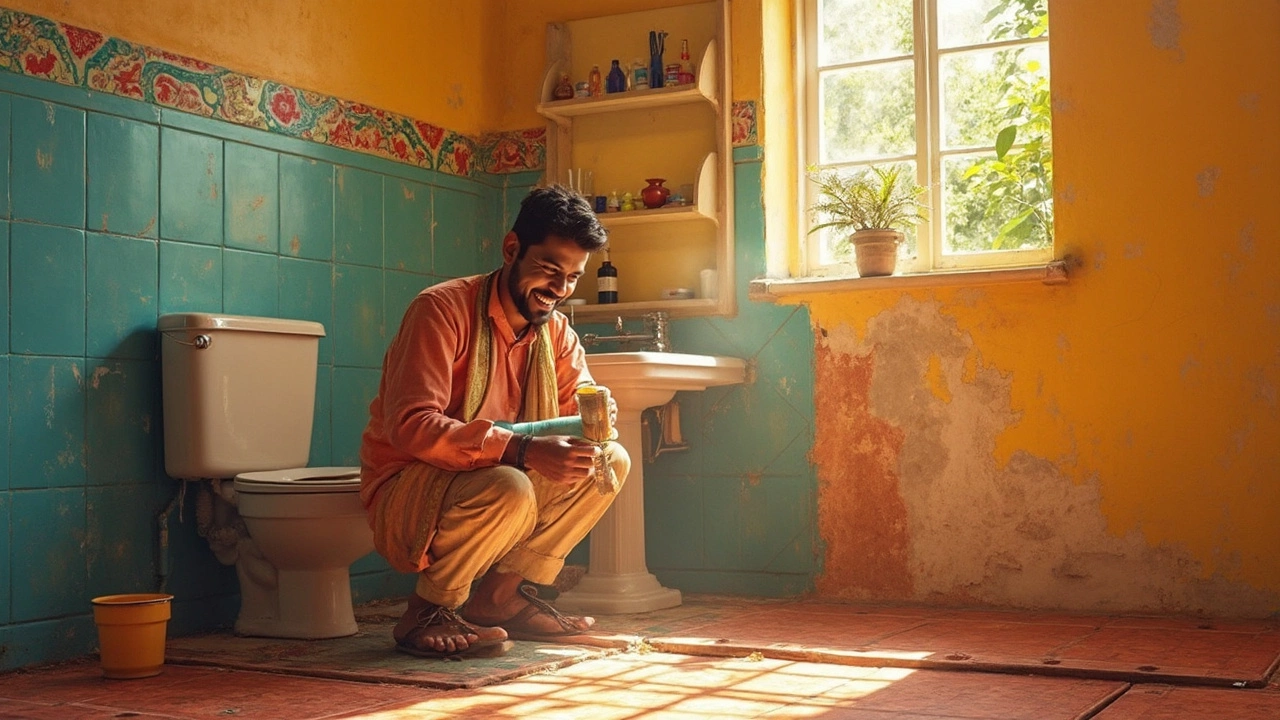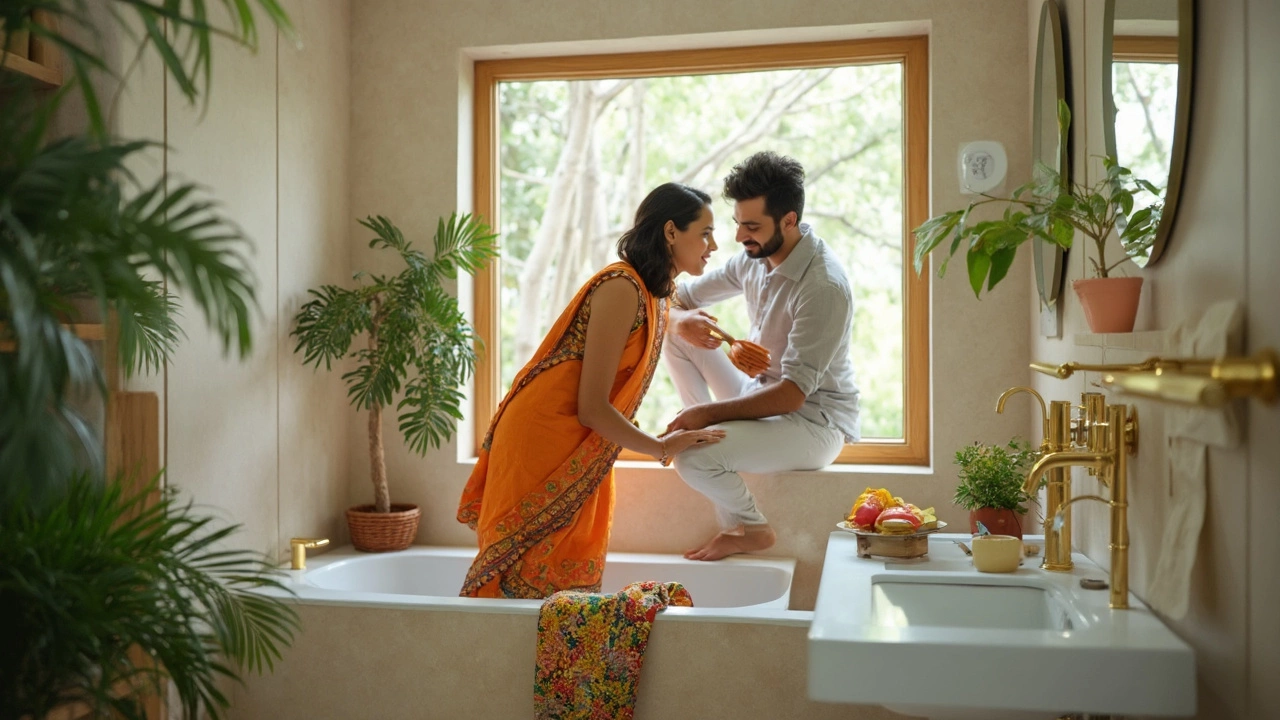Which to Tackle First: Walls or Floor in a Bathroom Remodel?

Remodeling your bathroom? The big question most people face is whether to start with the walls or the floor. You wouldn't think it matters much, right? But trust me, it can make a huge difference in the flow and outcome of the project.
Some folks like to tackle the walls first. The logic here is pretty simple: avoid any potential damage to a freshly laid floor from paint drips, drywall dust, or even just plain ol' foot traffic while working. Plus, you've got more flexibility to experiment with wall decor or paint without worrying about protecting your new tiles.
On the flip side, focusing on the floor first ensures you're setting a solid foundation—literally. Getting that perfect tile or hardwood laid down can dictate the rest of the space's vibe. Plus, it's easier to adjust or repaint walls to match the floor rather than ripping up floors because they clash with your new wallpaper or paint choice.
At the end of the day, it often comes down to personal preference, what you're comfortable with, and the specific demands of your space. Don't rush it—think about how you'll use the space, and talk to a few pros if you're unsure. They'll likely have insights from previous projects that can help guide your decision.
- Introduction to Remodeling Decisions
- The Case for Walls First
- Advantages of Starting with the Floor
- Material Considerations
- Practical Tips for a Smooth Remodel
- Final Thoughts
Introduction to Remodeling Decisions
Jumping into a bathroom remodel can feel like a rollercoaster ride. You're eager to see results, yet a bit wary about where to start. One thing is certain: deciding on what comes first—a focus on the walls or floor—is a crucial step. It affects everything from cost management to final aesthetics.
First off, let's consider your goals. Is your main aim to modernize the look, improve functionality, or perhaps boost your home's resale value? Knowing this sets the foundation for all your decisions and can help you prioritize your tasks more effectively.
Budget and Time Constraints
No one wants a remodel dragging on forever, right? Figuring out your budget beforehand can narrow down choices significantly. Whether you’re replacing, retiling, or repainting, each action has different costs and time requirements. For example, installing new tile floors demands more time and money than repainting walls.
In fact, a report from the National Kitchen and Bath Association suggests that tile flooring can take up to 20% of a bathroom remodel budget, which is a sizeable chunk to consider.
Impact of Design Choices
Your design choices can heavily influence whether you go with the floor or walls first. If you have a statement floor tile in mind, you might want that in place first as it becomes the anchor for the rest of your design. On the other hand, if a unique wall feature like textured panels is what's catching your eye, start there so you can plan the floor around it.
Remember, remodels aren't just about looks. They're also about improving functionality and user experience. Imagine slipping on wet tiles because they weren't anti-slip, or realizing your pristine walls are suffering from poor ventilation issues. Balancing looks with practicality is key to a successful outcome.
| Task | Average Duration | Impact on Overall Cost |
|---|---|---|
| Wall Painting | 1-2 days | Minimal |
| Tile Flooring | 3-5 days | Significant |
By keeping these factors in mind, you'll be better equipped to make informed choices that keep both your timeline and budget on track. And remember, any time you're feeling unsure, consulting with professionals can provide further clarity.
The Case for Walls First
Kicking off your bathroom remodel with the walls can be a smart move. Here’s why some experts and DIY enthusiasts suggest this approach. Getting walls sorted first helps you avoid a lot of mess and ensures a cleaner job overall.
Protection From Spills and Drips
Picture this: you’ve just installed a beautiful bathroom floor, and then you start painting the walls. Paint spills and drywall mud can easily damage or stain your new flooring. Tackling the walls first helps prevent this hassle. You get to work freely without the worry of ruining your brand-new tiles or expensive flooring.
Focus on Design Flexibility
Another big plus of the walls first approach is design flexibility. Getting the walls done gives you a cornerstone to build the rest of your design around. Whether you’re painting, tiling, or putting up wallpaper, knowing your wall color or pattern can guide you in choosing a floor that complements it perfectly.
Many professionals also advise on checking for repairs before anything else. Any structural repairs, including mold removal or plumbing fixes, are easier to do when the walls are down to studs. You wouldn't want to rip out a newly installed floor to fix something behind the wall, right?
Cleaning and Maintenance
Nailing your wall design first means less wear and tear from workers moving around with ladders and toolboxes. Plan it right, and you won't have to overly concern yourself with protecting floors from tradespeople's boots and tools during the installation process.
| Wall Material | Average Cost per sq ft | Time to Complete |
|---|---|---|
| Drywall | $1.50 | 2-3 days |
| Tile | $8-$15 | 4-6 days |
| Paint | $1-$4 | 1-2 days |
These figures give you a rough idea of what to expect budget-wise, depending on your material choice. Remember, the complexity of your design can also impact costs and timeframes. Choosing to start with the walls is typically a cleaner, more organized way to ensure everything comes together without the added stress of running into preventable messes or missteps later on.
Advantages of Starting with the Floor
Alright, so let's say you're game to tackle the bathroom remodel by starting with the floor. Why might this be a smart move? For one, laying the floor first gives you a clear visual and physical foundation to work with as you continue the project.
One big plus here is the ability to choose materials that perfectly capture the style you're going for without any existing decor getting in the way. You can select a stunning tile design or a timeless hardwood, and all your subsequent decisions about walls, fixtures, and decor will just fall into place. The floor sort of sets the stage, you know?
Minimize Overlaps
Starting with the floor also helps in minimizing overlaps. Imagine setting up a lavish tub or shower only to find that it doesn’t align quite right because the floor's layout wasn't properly considered first. Getting your floor perfectly in place can save you these alignment headaches down the road.
Ease of Access
If you're planning to install underfloor heating or any in-floor plumbing, knocking out the floor first makes installing those systems a breeze. Plus, this means you won't need to crack into the floors later, which can be both messy and costly.
Safety and Cleanliness
Working from the ground up can also keep things cleaner and safer. By having that foundational layer ready, you minimize the risk of damaging it later. Secured floors mean fewer trip hazards and also create a safer environment if you're using ladders or doing overhead work on the walls later on.
Material Compatibility
Sometimes, picking the floor material first ensures that the adhesive is compatible with the underlayers and the subsequent materials you'll use for the walls. This harmony between materials can be crucial for long-term maintenance and to avoid replacement headaches later.
But here's a quick note: Budgeting carefully is key. Floor materials can sometimes be pricier than wall options, so keep your budget in mind before splurging on those dream tiles. Always get a few quotes if you're hiring pros—prices can vary quite a bit.

Material Considerations
When you're diving into a bathroom remodel, one of the major aspects you'll need to focus on is the materials you're going to use for your walls and floor. The choices you make won't just affect the look of your bathroom, but also the cost, durability, and maintenance needs.
Choosing Wall Materials
For the walls, you've got a variety of options. Tile is a popular choice because it's water-resistant and comes in a multitude of styles and colors. Ceramic and porcelain tiles are common, but if you want a bit of luxury, glass tiles might be what you're looking for.
If tiles aren't your thing, consider waterproof paint or even some modern PVC panels. They're less expensive options and can offer a smooth, clean look. Just remember, whatever material you pick, it should stand up to humidity and constant moisture.
Flooring Selections
Flooring takes quite the beating in any bathroom. Moisture, daily traffic, and cleaning chemicals can all wear it down over time. For something durable and stylish, tiles are often a go-to choice. Porcelain is especially popular due to its non-porous nature and longevity.
Of course, you might also look into vinyl flooring, which is both cost-effective and water-resistant. Some newer options even mimic the look of wood or stone if that's the theme you're leaning towards in your home improvement project.
Budget and Lifespan
Budget will always play a role in your decision. Be realistic about what you can afford but balance that with how long you want the materials to last. Cheaper materials might save you money now, but they might not hold up in the long run, leading to costly repairs or replacements down the line.
Here's a quick look at the average lifespan of popular materials:
| Material | Average Lifespan (years) |
|---|---|
| Ceramic Tile | 75-100 |
| Vinyl | 10-20 |
| Glass Tile | 50 |
Remember, combining materials smartly can also give you the best of both worlds in terms of aesthetics and practicality. Just make sure whatever you choose fits your lifestyle and maintenance preferences.
Practical Tips for a Smooth Remodel
Alright, let's get those gears turning on how to make your bathroom remodel a breeze. It's easy to get lost in all the excitement, but making a plan can save you time and heartache later.
1. Set a Clear Budget
First off, set a clear budget. It's easy to get carried away with fancy tiles and luxury fixtures, but decide what's essential for your space. Keep some wiggle room—about 10-15%—for unexpected costs.
2. Choose Durable Materials
Picking the right materials is crucial. For example, ceramic tiles are a popular choice for flooring—they're durable, easy to clean, and can handle all that morning rush hour traffic. If you're thinking about walls, waterproof paint can save you from mold trouble later.
3. Sequence Your Tasks
Once you've decided on walls or floor, sequence your tasks logically. If you're hiring contractors, discuss the timeline upfront. Painting before flooring can help avoid splatters, while flooring first might give you a better visual of the space.
"Good design is making something intelligible and memorable. Great design is making something memorable and meaningful." — Dieter Rams
4. Ventilation is Key
One thing that's non-negotiable, especially in a bathroom, is ventilation. Ensure you've got a good fan installed. It prevents moisture buildup that could ruin that fresh paint job or warp your floors.
5. Storage is Not an Afterthought
Have you thought about where you'll store towels, toiletries, and the gazillion other bathroom goodies? Incorporate enough storage in your design. Maybe add a few cabinets, or think about clever shelving solutions.
6. Inspect the Plumbing
Lastly, never underestimate a plumbing check. Before you start tearing down walls or ripping out floors, ensure the plumbing isn't as outdated as your 90's playlist. Upgrade where needed, saving potential headaches down the line.
Oh, and one more tip—if you're DIY-ing, don't hesitate to call in the pros when you're out of your depth. It's worth it for the peace of mind (and avoiding flooded floors!). Now go forth, and may your bathroom renovations be ever in your favor.
Final Thoughts
So, you've made it to the end of our bathroom remodel journey. Picture your finished space; it probably looks amazing, right? Deciding whether to kick things off with walls or floor can be a make-or-break choice, but don't sweat it too much—both have their merits.
Summary of Priorities
When weighing your decision, remember the fundamental need for protecting newly installed elements from inadvertent messes. If you're someone who tends to make a mess during projects, you might lean towards starting with the walls first so you don't risk damaging that pristine new floor.
On the other hand, starting with the floor can set a visual and practical foundation that drives subsequent choices. Picture how the color and texture of a stunning floor can inform the color palette and decor style throughout the rest of the room—sometimes, it just makes sense to start from the bottom up.
Practical and Emotional Considerations
Both choices can also come down to what feels right for you. Take into account your personal comfort level with different project phases. If you love painting but hate grouting, maybe getting the floor done first will mean diving right into the part you'd rather leave to the pros.
Durability is another aspect worth considering. While budget-friendly materials might save you upfront, often they can cost more in the longer run with frequent replacements or touch-ups.
Professional Insights and Stats
Want some numbers to back up the choice? A survey by the National Kitchen & Bath Association in 2023 found that 65% of contractors preferred starting with walls during a bathroom remodel, citing it as more time-efficient in fast-paced projects.
Here's a quick recap in a handy list:
- Starting with the walls might be preferable if you're concerned about mess and post-floor installation protection.
- Choose the floor first if the visual impact of your flooring influences the overall room design.
- Got professional assistance? Discuss options—they've got insights from countless remodels.
Final Advice
Whatever you decide, just remember one thing: each step brings you closer to a space that's a perfect fit for your lifestyle. Weigh up your priorities, take things one step at a time, and enjoy the process. And hey, once you finish, it's time to kick back, relax, and enjoy your newly revamped bathroom space.

